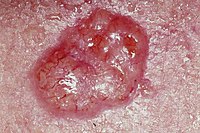
Photo from wikipedia
ABSTRACT Doxorubicin (DOX) is a commonly used drug in the treatment of cancers, while its application in clinical stage is restricted due to side-effects such as cardiomyocyte injury. Increasing studies… Click to show full abstract
ABSTRACT Doxorubicin (DOX) is a commonly used drug in the treatment of cancers, while its application in clinical stage is restricted due to side-effects such as cardiomyocyte injury. Increasing studies indicated that ozone may protect cardiomyocytes from injuries. The present study aimed to explore the effects of ozone on cardiotoxicity induced by DOX treatment. Rat heart myoblasts (H9c2) were treated with increasing concentrations of DOX (0.5 μM, 1 μM, 1.5 μM, 2 μM) to induce cell injury. MTT assay and flow cytometry analysis were used to measure the viability and apoptosis of H9c2 cells. The mRNA and protein levels of proinflammatory cytokines (TNF-α, IL-1β, IL-6), matrix metalloproteinases (MMP-2, MMP-9) as well as the key factors on the TLR4/NF-kB signaling (TLR4, p-p65, p65) were measured by RT-qPCR, ELISA and western blot. The result showed that DOX promoted apoptosis and increased the expression of TNF-α (by 3.65 fold changes), IL-1β (by 4.98 fold changes), IL-6 (by 3.44 fold changes), MMP-2 (by 1.98 fold changes), MMP-9 (by 1.98 fold changes) levels in H9c2 cells. Moreover, the introduction of ozone reversed these changes in gene expression and suppressed the activation of the TLR4/NF-kB signaling, which indicated that ozone may exert protective effects on H9c2 heart myoblasts by relieving the cardiotoxicity induced by DOX. Our study provides theoretical basis for the significance of ozone in managing doxorubicin-induced H9c2 heart myoblast injury.
Journal Title: Journal of cardiovascular pharmacology
Year Published: 2021
Link to full text (if available)
Share on Social Media: Sign Up to like & get
recommendations!